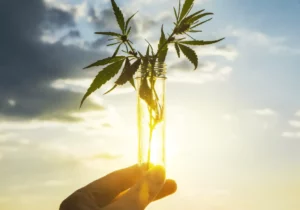Sometimes feeling good is as simple as smoking some weed or eating your favorite edible. When you feel the euphoria from getting high, you may ponder deep existential questions or laugh louder than usual during your favorite TV show. Depending on the strain, THC might energize you, and you end up cleaning your house until it shines like a new penny. Or maybe it makes you more creative, and you spend hours painting your next masterpiece. The bottom line is, you feel good. Now, the question is, how does weed work to get us there?
Tapping into the Endocannabinoid System
We used to believe that the feel-good high associated with marijuana was caused by a flood of dopamine released by the ingestion of tetrahydrocannabinol (THC). But now, researchers and scientists credit that famous high to the interaction of THC with receptors in the endocannabinoid system (ECS), a network of cells found throughout the body and brain that responds both to naturally produced cannabinoids and those found in the cannabis plant.
The ECS controls the release of every neurotransmitter in the brain—molecules that the brain cells, or neurons, use to communicate with one another. One neuron sends a message to the next by releasing neurotransmitters, such as dopamine or serotonin, into a gap that separates one neuron from the next; this is called the synapse.
Marijuana has many cannabinoids, but only cannabinoids that activate the endocannabinoid system’s CB1 receptor can cause psychoactive effects. That group includes CBN, THCV and THC. CBN and THCV can produce mild sedating and calming effects, but THC is the cannabinoid that’s primarily associated with psychoactive effects.
We now know that THC can activate the CB1 receptor in the same way as our bodies’ naturally occurring, pleasure-inducing endocannabinoid—anandamide. It’s this interaction that can make us feel happy and relaxed after ingesting cannabis.
When THC enters the brain, the molecules spread into the synapses, where they activate CB1 receptors. It decreases the likelihood that the presynaptic neurons it affects will temporarily stop sending the usual neurotransmitters. In effect, THC comes into the ECS like a mighty wave, flooding it with feel-good signals the postsynaptic neurons didn’t send—giving you that high you love.
From the Mouth to the Mind: How THC Gets to the Brain
Okay, great, that’s the science. But now you’re asking—how does weed work to make you us feel good? Well, not only does it depend on what you take (a strain high in THC, for example) but how you take it—smoking, inhaling or eating an edible.
If you smoke or inhale cannabis, it goes from your lungs to the bloodstream very quickly. Within 20 minutes, your circulatory system delivers THC molecules to every tissue in the body, including the brain, where it can alter neural chemistry.
On the other hand, edibles take a more leisurely trip through the digestive system to the liver, where metabolizing enzymes turn THC into a different compound that takes longer to exert its mind-bending effects. Edibles may take longer to work, but their effects may also last longer than smoking or vaping. One study reveals that oral ingestion of THC requires 30 to 90 minutes for effects to begin, and they reach their peak after two to three hours.
Not Everyone Feels Good with Weed
Not everyone’s experience ingesting cannabis is the same. While many people have good and pleasurable experiences, others, perhaps because of differences in their ECS, may wind up feeling anxious, afraid or panicked.
In high doses, THC can make you paranoid and lose touch with reality. It can also cloud your perceptions and may give you poor judgment or lower mobility response time. The effects depend on how strong the marijuana was, how you’ve consumed it and how much you’ve used in the past. There’s a chance that it can result in the following:
- Heightened senses
- Distortion of time
- Effected motor skills
- Lowered inhibitions
- Increased depression
Combining THC with CBD (cannabidiol) can help to reduce the anxiety and other unpleasant feelings that THC can cause. Some research also suggests that THCV might block some of THC’s effects on the CB1 receptor.
How Does Weed Work for Depression and Anxiety?
There’s evidence to suggest that medical marijuana can help with many conditions, including chronic pain, depression, anxiety, and treating nausea and vomiting related to chemotherapy. Other potential benefits include the following:
- Involuntary movements associated with movement disorders
- Sleep disorders
- HIV-related weight loss
- Spasticity in people with multiple sclerosis
So, the positive emotions and euphoria from cannabis can help with feelings of anxiety and may help with depression as well. That’s not as well documented by research to date, but some research shows that medical marijuana can help stabilize the ECS, bringing back normal function and helping to improve depression.
Some studies show that stress can suppress the brain’s production of endocannabinoids, causing depressed behavior. Using cannabis can restore normal levels and functions, improving the symptoms of depression and anxiety.






